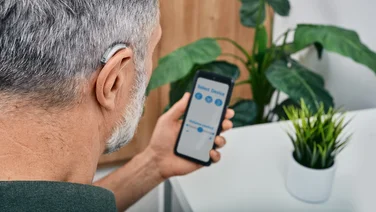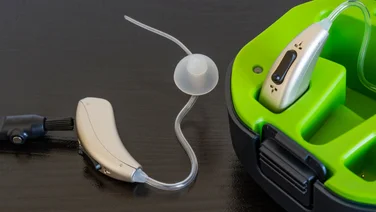To help us provide you with free impartial advice, we may earn a commission if you buy through links on our site. Learn more

Invisible hearing aids are so small and discreet that it’s unlikely that anyone will catch a glimpse when you’re wearing them. Enhancing hearing without feeling bulky or being noticeable, these tiny digital devices could help transform the lives of millions of people who have up until now been put off hearing aids as a result of their appearance and size.
“Invisible hearing aids” is the more catchy name used for completely-in-canal (CIC) and invisible-in-canal (IIC) hearing aids, which sit deep inside your ear. Their dinky size means that while they might not be powerful enough to benefit people with severe hearing loss, they’ll effectively enhance and clarify sound for anyone whose hearing loss is mild to moderate.
These tiny types of hearing aids tend to cost more than behind-the-ear (BTE) and in-the-ear (ITE) hearing aids, but not all models are at the top end of the price scale. Among the cheapest invisible hearing aids are the Signia Silk 1x (£599/single or £1,098/pair), while the rechargeable invisible model of the feature-packed Starkey Evolv AI costs £3,595/pair.
Read on for a deeper dive into the pros and cons of invisible hearing aids, including their sound-enhancing power, comfort levels and price.
Have an idea of your requirements? You can use our free quote finder tool to be matched to a local hearing aid specialist.
Get a free quote for hearing aids today
Take our quick survey below and we’ll give you a quote for hearing aids that meet your requirements.
What are the advantages of invisible hearing aids?
Discretion is the game-changing advantage of invisible hearing aids. These devices aren’t just small, they have no external tubes or wires, so no-one need know you’re wearing a hearing aid.
According to the RNID (Royal National Institute for Deaf people), one in five UK adults (12 million) suffer from hearing loss, rising to a predicted 14.5 million by 2035. But take-up of hearing aids is very low, according to organisations including the RNID and Hearing Link. Only just over 3% of UK adults wear hearing aids, compared with 59% who wear glasses.
The RNID doesn’t explicitly say that the appearance of hearing aids puts people off, but hearing aid manufacturers aren’t so coy. “Big and beige is no longer an option” proclaims Starkey, whose new Evolv AI range is available in tiny CIC and IIC models.
Most invisible hearing aids are available in a choice of colours including black, white and beige. Beige may seem more natural, but darker colours make the device even less easy for other people to see.
Appearance (or lack of it) isn’t the only advantage of invisible hearing aids. Here are a few more…
- Invisible hearing aids don’t stop you wearing glasses, hats, headphones, wigs and face masks. This is a big step forward from traditional BTE devices, which can prove too bulky to let you wear anything else on your ears at the same time.
- Many people find invisible hearing aids more comfortable than BTE hearing aids, which can be itchy at first.
- Invisible hearing aids fit more securely inside your ear than larger hearing aids. If you’re an active person, you’ll welcome the freedom to move around without feeling your hearing aid slipping out of place.
- Larger hearing aids can be sensitive to wind noise, because they’re exposed to rushing air. This doesn’t happen with in-canal hearing aids, which are protected by your outer ear.
- Some invisible hearing aids allow air to move through your ear canal. This avoids the hollow booming effect known as “occlusion”, which can happen with custom-made and full-shell ITE hearing aids that completely fill the wearer’s canal.
Are invisible hearing aids custom-made?
As with ITE hearing aids, invisible hearing aids can be custom-made to fit your ear canal, but they’re also available in instant-fit models. Each type has its own advantages.
Custom-made invisible hearing aids are moulded to fit your ear canal perfectly. Thanks to their exact fit and light weight, these hearing aids are supremely comfortable. However, they can create the occlusion effect that custom-made ITE hearing aid wearers sometimes experience, especially when first wearing them.
Instant-fit invisible hearing aids have a soft silicone sleeve that sits comfortably in the canal, like a very small earbud. Air can move a little more freely, which can do away with that blocked feeling. Also, you can wear instant-fit hearing aids straight after your appointment because they don’t need to be moulded specially for your ear.
READ NEXT: How do hearing aids work?

What are the disadvantages of invisible hearing aids?
Given their tiny size, invisible hearing aids aren’t as powerful as larger BTE models. BTE hearing aids can now help people with severe hearing loss, of greater than 65 dBHL (decibel hearing loss), while invisible models are best suited to people with mild to moderate hearing loss. A qualified audiologist will be able to advise you on the type of hearing aid that best suits your level of hearing loss.
Here are a few more drawbacks to ITE hearing aids…
- The tiny size of invisible hearing aids, and their position inside the wearer’s ear canal, can make them fiddly to handle.
- Such hearign aids use very small batteries, which have shorter life and can be difficult to insert. Many invisible hearing aid manufacturers and retailers offer a rechargeable option for £100 more than the standard model, and this is well worth the investment because it means you don’t have to fiddle with batteries at all.
- If your ear canal is small or narrow, invisible hearing aids may be too large to fit inside them. These types of hearing aid may also be unsuitable for those who frequently suffer from ear infections.
- Cleaning can be an issue with invisible hearing aids, because they sit so snugly in your ear and can become clogged with earwax.
- Smaller hearing aids can sometimes compromise functionality as well as audiological performance. For example, there isn’t enough room in tiny CIC and IIC hearing aids for two microphones, which can be a real benefit in places with lots of background noise.
READ NEXT: Rechargeable hearing aids
How much do invisible hearing aids cost?
Invisible hearing aids cost from around £1,000 per pair to more than £3,000 per pair. The more expensive models tend to boast greater audio power and more advanced features, but no invisible hearing aids are suitable for people with severe hearing loss.
At the more affordable end of the spectrum are hearing aids such as the Signia Silk 1x, (£599/single, £1,098/pair), which comes with the free Signia app for making remote adjustments via your phone. Noise reduction features, sound processing options and listening programmes are limited to the basics, but this is a quality device that’s designed to deliver clear speech to people with mild to moderate hearing loss.
At the top end of the price spectrum are premium devices such as the Phonak Paradise Virto P-Titanium (£3,445/pair), which Boots describes as “the smallest Phonak hearing aid ever”. It’s made from titanium, which is supremely lightweight and durable, and the device is fully automatic, so there’s no need to manually adjust it. However, there’s no instant-fit or rechargeable option.
The Starkey Evolv AI 2400 invisible hearing aids (£3,395-£3,595/pair) come in custom-made and instant-fit models, and with a rechargeable version – so all options are covered.
How do I choose the best invisible hearing aid for me?
Choosing the best hearing aid for you requires the help of a trained audiologist. They can accurately measure your hearing loss and type, and take into account the factors that affect you.
If you’re looking for a custom-made invisible hearing aid, your audiologist will also take an accurate mould of your ear, which will enable them to build a hearing aid that will fit into your ear perfectly.
Use our quote-finder tool to discover the type of hearing aid that would best suit you, and to discuss the best options for helping you hear more easily and clearly.






